
Cuisine, Culture, and Mythology in Crete
- Amy Digges
- Jul 21
- 16 min read
Updated: Jul 22
Well, unbeknownst to us, we saved the best for last. I knew very little about Crete before arriving on its shores, and I'm betting you might be the same. Crete is the largest—and southernmost—of the Greek islands, though “large” is relative. It’s about the size of Alabama, and that’s probably where the comparison ends. Here you’ll find jaw-dropping mountain ranges, turquoise coves, and enough mythology to last for days and days. Crete stretches roughly 160 miles long and 37 miles wide, and on its southern coast, you’re looking at the last piece of land before you hit the shores of Libya and Egypt. Basically, if you kept swimming south for 180km, you’d be in Africa. Not recommended, but it’s good for perspective.
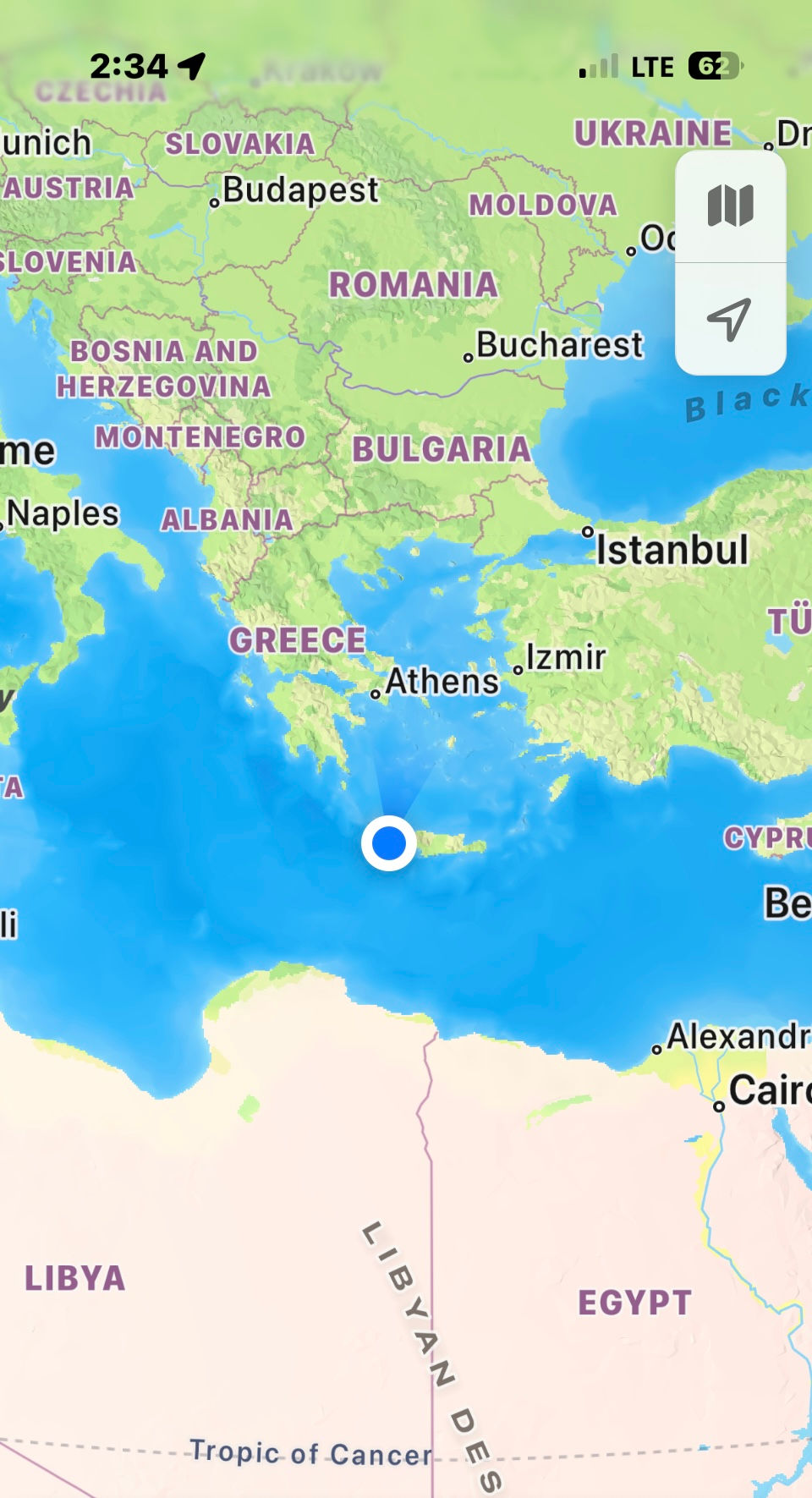
Fun facts about Crete:
Crete is home to the Knossos, the oldest city in Europe, dating back to 7,000 BCE. It's often considered the birthplace of European civilization.
The island was the center of the Minoan civilization, one of the earliest advanced cultures in Europe.
According to Greek mythology, Zeus, the king of the gods, was born in a cave on Crete.
With more than 600,000 residents, Crete boasts an astonishing 62 olive trees per person—that’s a lot of olives!
The island’s crystal-clear waters offer visibility up to 50 meters deep.
Though known for its beaches, snow blankets the mountains of Crete from November to May.
After a lunch at the port in Santorini, we hopped aboard a relaxing two-hour ferry (truthfully, they all are) from Santorini to Heraklion, Crete’s capital and main port. From there, we rented a car and began the 2-hour drive west to Chania (pronounced Ha-nee-uh). With the Aegean Sea on our right, we drove West into the sunset.

We arrived around 9:30 p.m. and met our host, Giannis, who led us on a short walk from the car to our home for the next week: a surprisingly spacious spot that blended traditional cave architecture with modern-day comforts and three legitimate bedrooms! Someone wasn’t on the couch in the living room!

And the location? Perfection. Just one block from Chania’s U-shaped harbor, where outdoor restaurants and cafes line the waterfront like a lighted parade, each one competing for your attention with local wine, and the occasional sizzling plate of grilled octopus or kebabs while local bouzouki players entertain with ridiculously fast fingers.

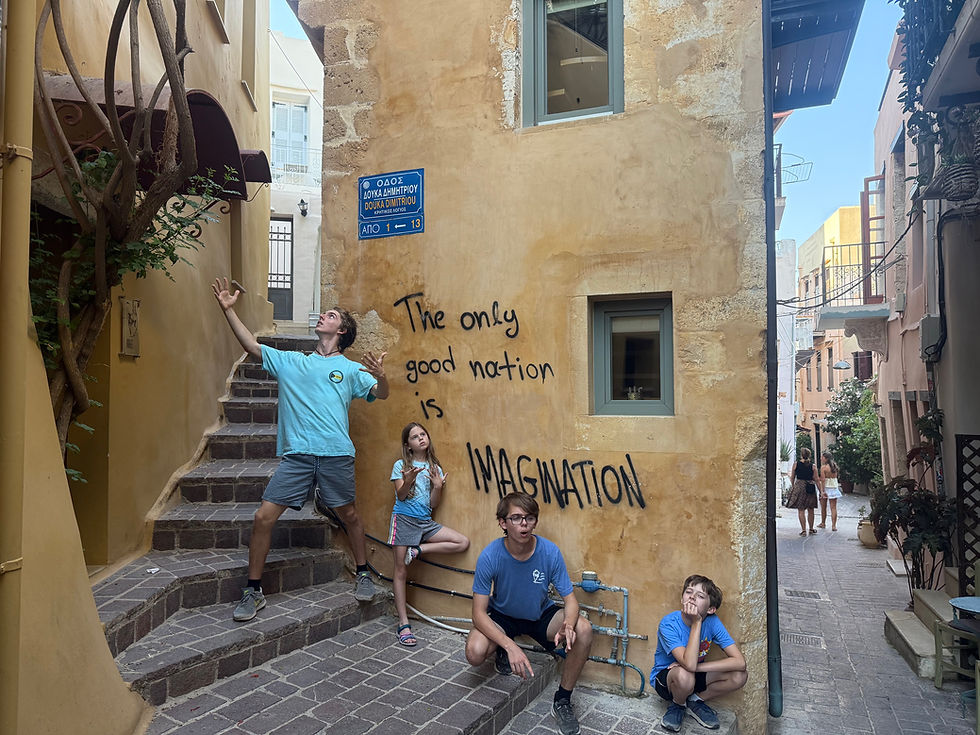

Across the harbor, the old Venetian lighthouse keeps watch over the Aegean.


Gone were the Cycladic whitewashed cubes of Santorini. Here we saw colorfully painted three-story buildings in soft pastels and terracottas, shutters thrown open to catch the sea breeze, and wrought-iron balconies that curled and twirled like a mustachioed old man. Cobblestone alleys twist and turn like ancient veins through the heart of Chania’s Old Town. Each turn reveals something new. Mingling with the tourist shops selling evil eyes and
t-shirts, the air is ripe with the scent of fresh fish, olive wood, and leather drifting from open workshop doors. Colorful handwoven textiles sway in the breeze next to stalls stacked with shelves of hand-painted ceramics. It all stirred memories of our wanderings through the souks of Marrakesh in 2022—only here, the pace was slower, and the energy quieter. Chania doesn’t try to dazzle with postcard perfection. Instead, it leans into its centuries—layered, lived-in, and wise.


After catching our breath (and a good night’s sleep), a short stroll the next afternoon brought us to the Maritime Museum of Chania—an unexpected gem at the edge of the harbor. Inside, we found an impressive collection of handcrafted model boats, painstakingly built to represent everything from Minoan trading ships to modern naval vessels.

The museum also featured an entire wing of taxidermied sea creatures—an odd but fascinating lineup that included blowfish puffed to maximum capacity, enormous crabs that looked like they’d taken steroids, delicate nautilus shells, and a few sharks in mid-snarl. If there were ever a museum built for Gaelan, this was it—well, unless there’s one that also features a T. Rex petting zoo.


The pride Cretans take in their naval heritage was on full display. From boat building to sea navigation, they’ve been masters of the waves for millennia. And it doesn’t stop in ancient times—Crete played an important role in World War II, with fierce resistance against the Nazis. It’s the kind of bravery that somehow never made it into our American history textbooks.

That evening, just as the sun set, we made our winding way to the lighthouse perched on a small spit of land before heading to our first dinner in Chania.
Posing inside a stone archway with a window to the sea quickly turned into an impromptu photo shoot serving up either reflective vibes...

...or full-on sacrificial sister energy?

Giannis had recommended Tamam, a restaurant so unassuming from the outside, we nearly missed it. We bypassed the busy harbor crowds and turned down a side street, almost walking right past the dark wooden door marked only by a small, subdued sign.

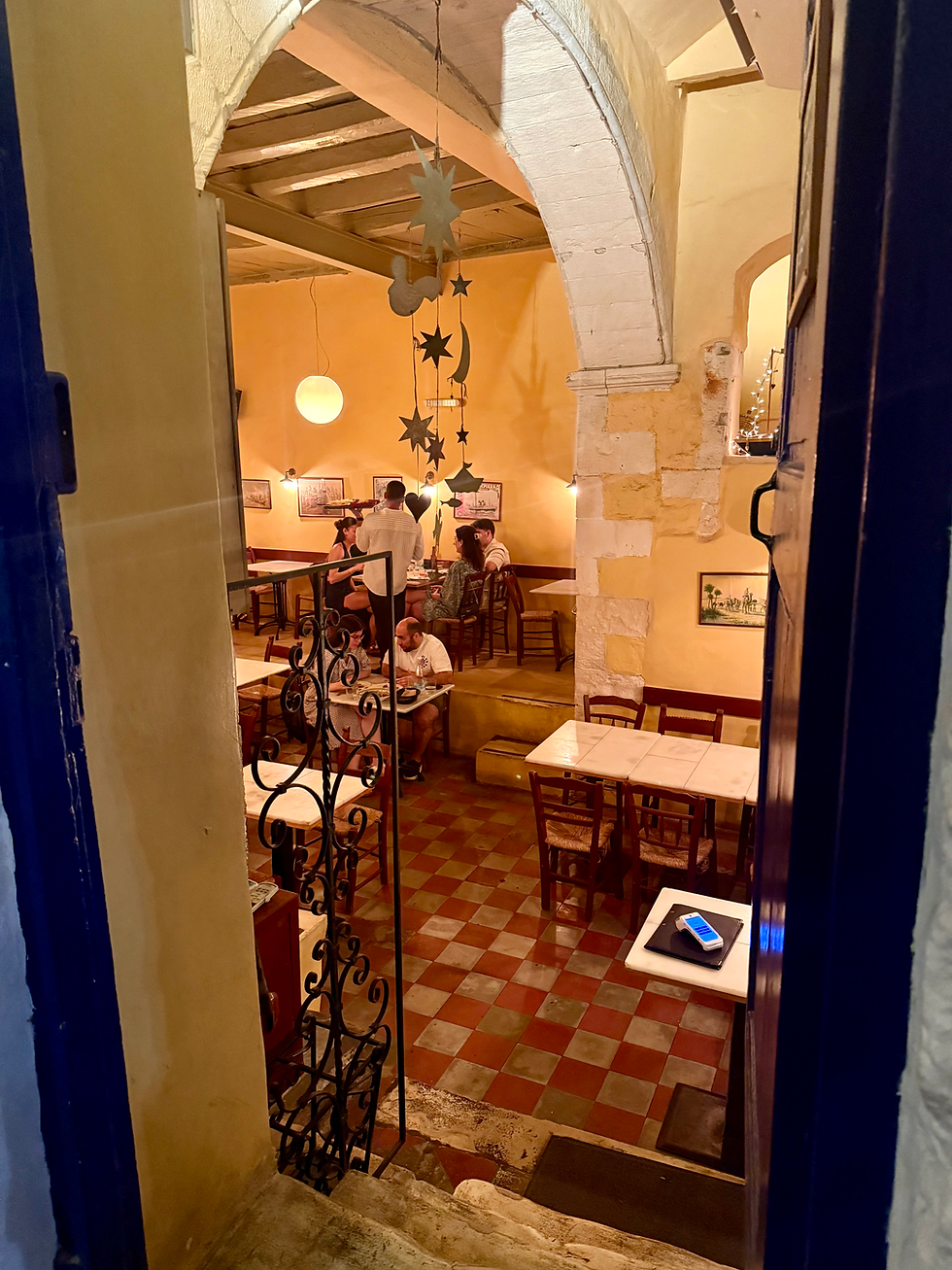
Stepping inside felt like entering an old Middle Eastern home. The walls, painted in warm mustard tones, glowed under soft light. Simple paintings of camels and desert landscapes hung slightly askew, adding a certain charm while succinctly telling the customers, “Trust us. You’re not here for the decor.” The compact, square room was anchored by a ledge that wrapped around its perimeter—diners sat at tables either on the floor or along the raised edge.
We later learned that Tamam was once a hamam, a traditional bathhouse. The dining floor had once held the bath itself, while the ledge had served as a sitting area. When the building was repurposed, they shifted just one letter—Hamam became Tamam, which means “perfect” in Arabic.

The food? More than perfect. Fragrant spices and bold flavors filled the table: lamb kebabs, rice with almonds and apples, juicy meatballs, roasted chicken legs, and a phyllo pie stuffed with a stew so rich and layered, I’m still thinking about it nearly a week later. Mediterranean meets Middle Eastern—I’m telling you, there’s no better pairing.
The following day, an hour’s drive west brought us to Falassarna Beach—ranked among the top 25 beaches in the world. Crystal-clear turquoise water, gentle, clockwork waves, a sandy bottom, and a wide sandbar about 50 yards out created the perfect playground. The older two had a destination to swim toward and "big enough" waves to conquer, while the younger two found just enough thrill in the breakers closer to shore.

It’s surprisingly rare to find a beach that strikes the right balance for everyone, ages 8 to 16—but Falassarna, you came through.
We staked out a spot beneath a straw cabana with three lounge chairs, and our path to the water became a game of shadow-hopping to avoid scorching our feet on the intensely cooked sand. Once in the water, Onora vascillated between panicked hyperventilation and gleeful squeals—all within the same breath. Teaching her how to roll with the waves and gain confidence in the water feels like one of those life skills we’ll be working on for a while…


A family soccer game at the shoreline came with an unexpected twist: the sea decided to join in. Unpredictable and unbiased, it played for both teams — sometimes stopping the ball in its tracks, sometimes stealing it altogether. Try kicking a ball through three inches of surf, and you never know where it’ll end up.
Lunch arrived right to our cabana—pizza and burgers, our only non-Greek meal of the trip. The verdict? Let’s just say the pizza earned a collective “meh.” Quinn decided that dousing it with ketchup might right the wrong. Some things are better left to the Italians.

By Monday, we were ready for a full day of sightseeing, starting with a drive to Rethymnon (ruh-thim-naan), another Venetian port city—larger than Chania, but with glimpses of the same romantic charm. Our mission? To witness the craft of the “last traditional phyllo maker in all of Crete.”

The famed master, now in his mid-nineties, has recently retired, but his son and grandson now carry the torch. Inside a bare-bones kitchen—little more than a sink, a table, and two massive 12-foot-square workstations—we watched the magic unfold. Dough was mixed and kneaded, then spun overhead like a pizza, each disc growing until it reached nearly three feet in diameter. The maker threw it onto the center of the table where it ballooned like a parachute. Remember that old elementary school gym game? We'd flap the parachute, then duck inside and sit as it billowed above us? It looked just like that.


Then came the real artistry. The dough was stretched, slowly and methodically, by walking in circles around the table. With each pass, it thinned until it draped over the sides, creating a slightly transparent veil of dough.

When finished, they trimmed the excess and started all over again. Every day, they make 36 of these massive, whisper-thin sheets to sell or to use in their honey-soaked creations like baklava. Of course, we bought some for a pick-me-up later in the day.
The work is quiet and meditative—no music, little conversation, just rhythm and repetition. It wasn’t flashy or fast-paced, but it was deeply satisfying to watch masters in their element.
On the way back to the car, Kip spotted an open workshop and did a double-take. “Hey, that’s the guy I saw on YouTube,” he whispered, pointing. Inside, a handsome, muscled Greek man leaned over his work table, tools scattered across the space.

The back wall revealed the fruits of his labor: hand-carved traditional Greek stringed instruments—lyras and bouzoukis—each one inlaid with intricate designs, including a carved griffin vulture on the back of each one.


Nikos greeted us warmly, eager to chat, explain his process, and even play a tune. The craftsmanship was incredible—sound and form working in harmony. The starting price was a bit steep for us, but I told myself: if I ever learn to play the lyra, I’m coming back.
No shade to woodworkers, but let’s be honest—when your creation has to sound good too? That’s another level. I’ve never asked my chairs to be in tune.
We continued on to our next stop, winding into the hills west of Panormo to visit Melidoni Cave—a place that has seen everything from ancient habitation to sacred rituals to heartbreaking tragedy.

Archaeological finds—fire pits, clay pots, and cooking tools—date back as far as 5,000 BCE, when the cave served as a shelter. But from the Bronze Age through the Minoan period, it was primarily a site of worship.
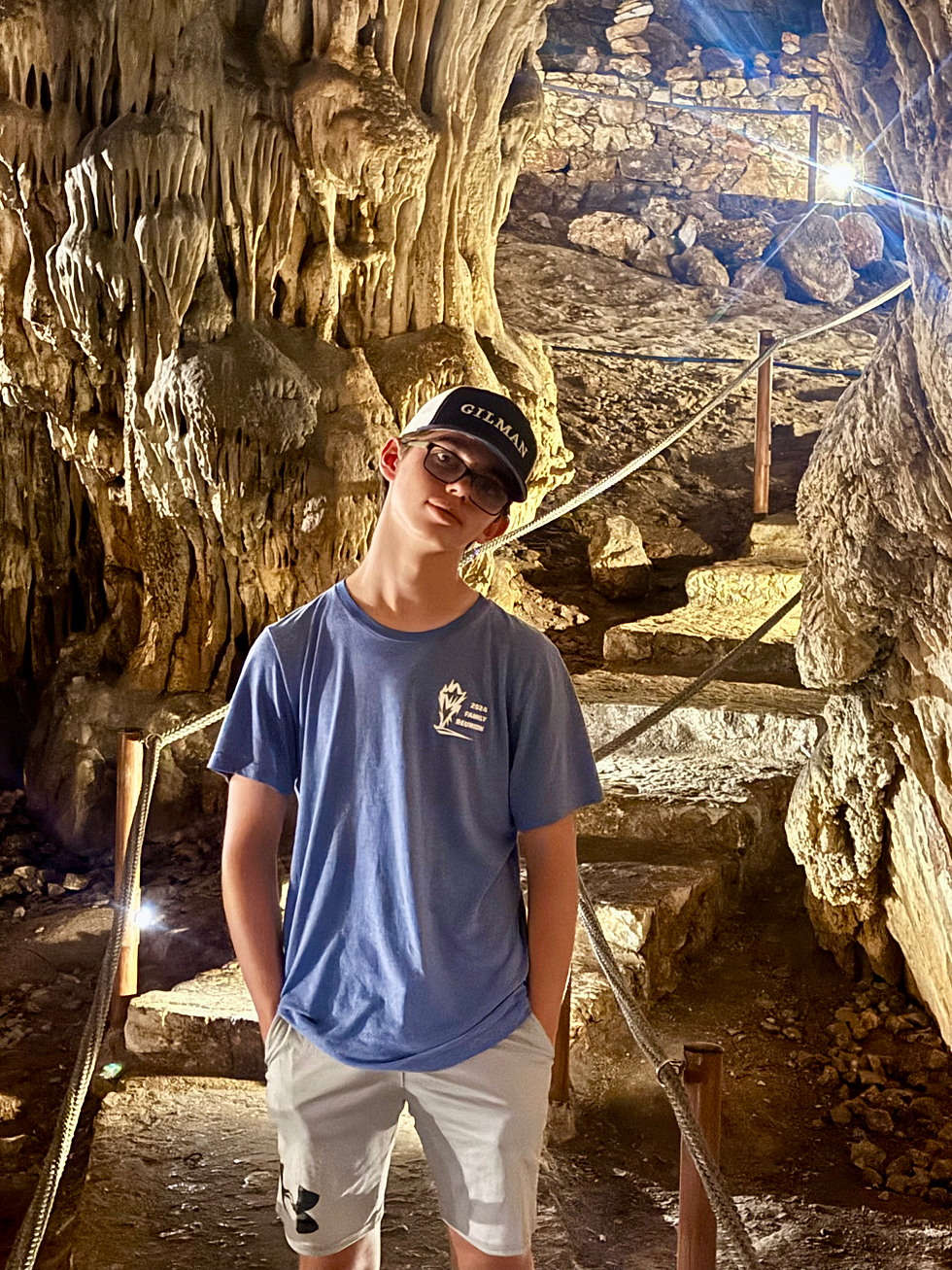

Then came one of the darker chapters in Crete’s history. In November of 1834, during the Cretan resistance against Ottoman rule, 340 women and children and 30 soldiers sought refuge inside the cave. When they refused to surrender, the Ottoman general sealed the entrance and set fire, suffocating everyone inside. The charred remains were only discovered in 1999.
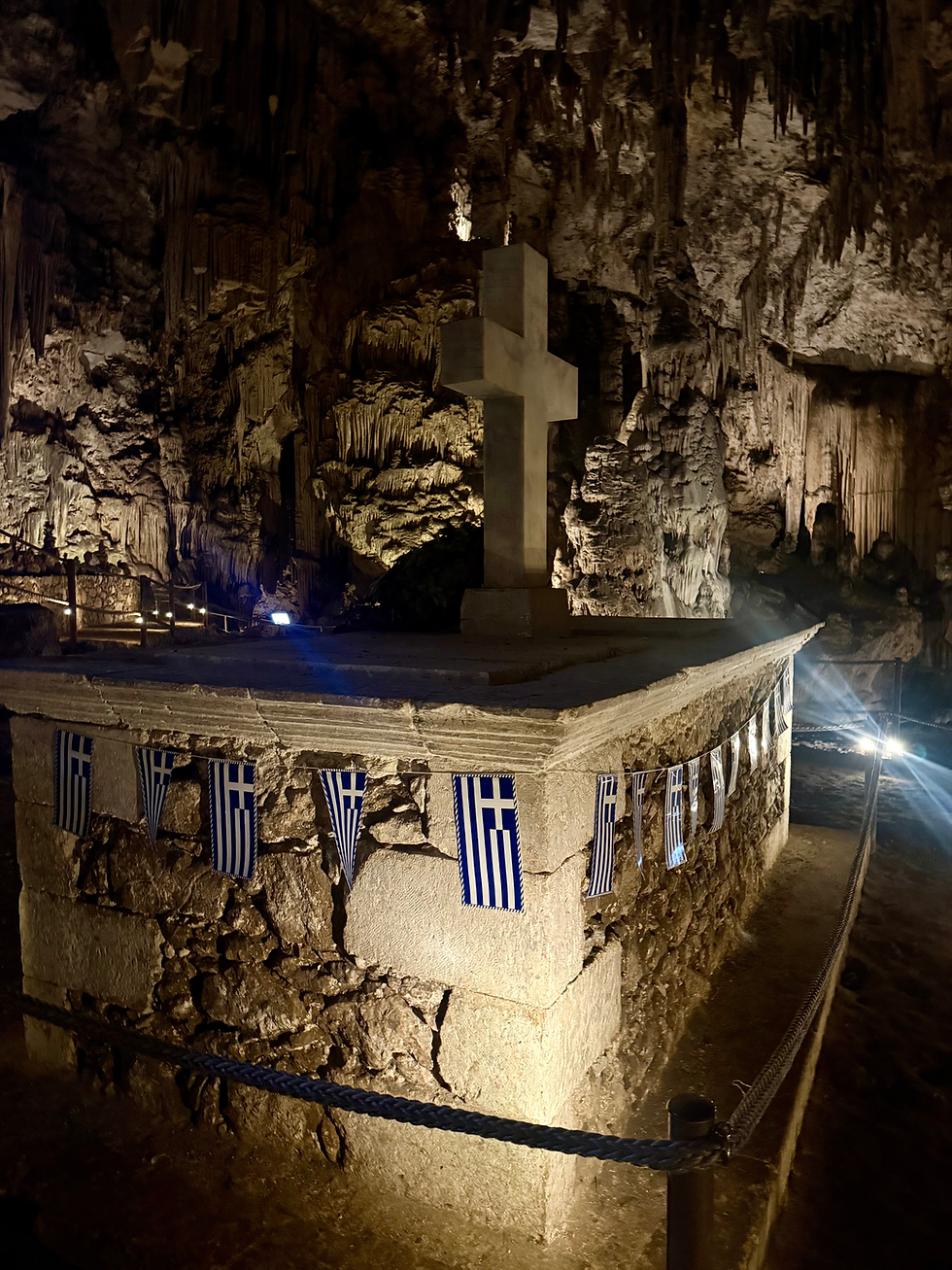
At the bottom of the cave, a warmly lit memorial honors those lost. You emerge into the sunlight, blinking, and can’t help but think about what kinds of things people can justify doing to others.
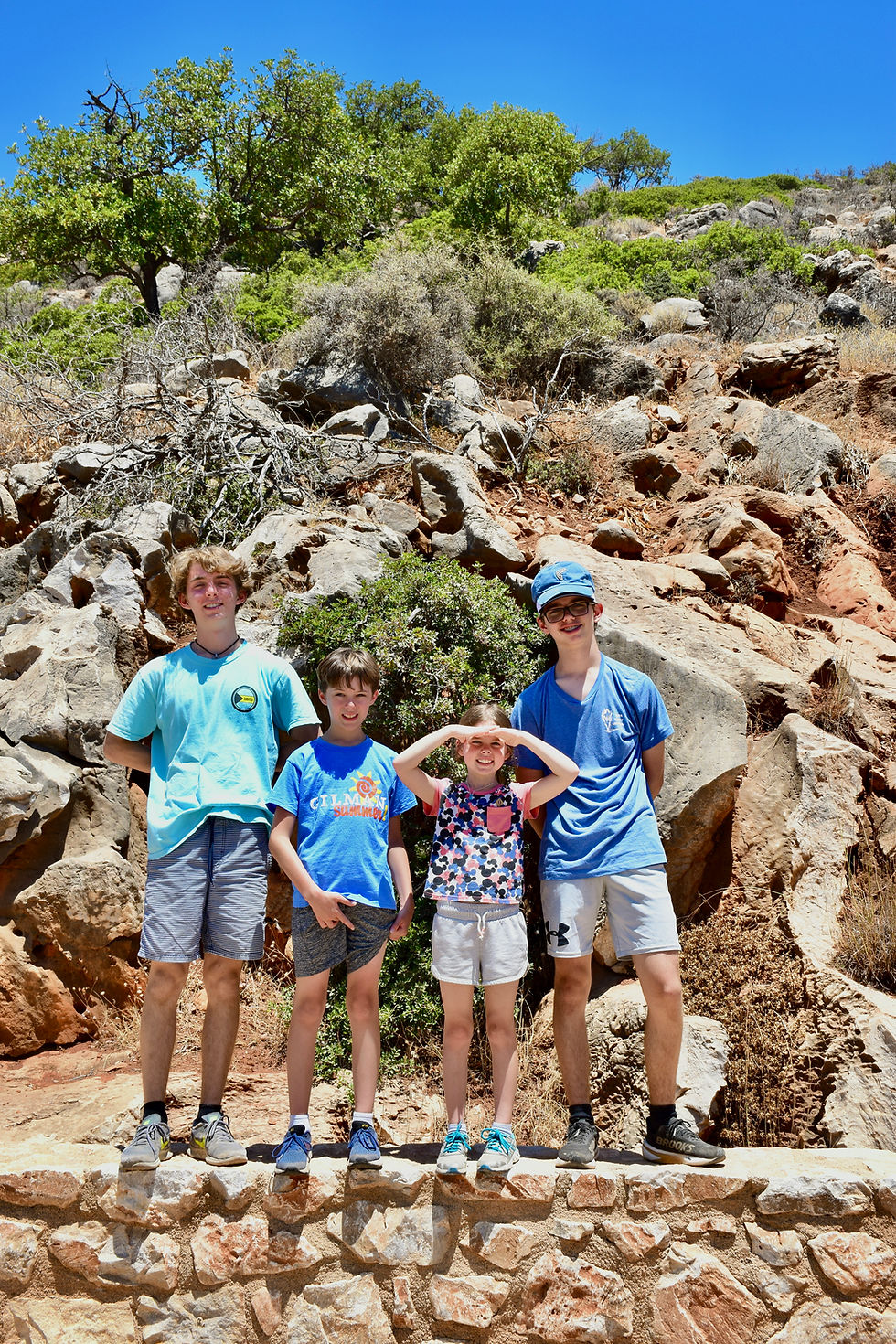
And then...the sweat returns. Instantly. A second or maybe third layer of damp since we started the day. Okay, I admit it: Greece is hot. But it’s a tolerable kind of heat—dry and manageable if you cling to the sides of buildings like a lizard hunting for shade. Give me Greek heat over a Baltimore summer soup any day.
So when we passed the cafe on the way out with fresh smoothies, it seemed destined. Under a vine-draped arbor, overlooking the hills, we dug into our honeyed phyllo treats from our stop this morning and dreamy fruit smoothies. Could it get any better?
From there, we took a short three-minute drive to Reptisland. We weren’t sure if it would be a hit or a total bust. That question was answered the moment we walked in, when a staff member unceremoniously placed a bearded dragon in my hands without a word.

For the next hour, we found ourselves completely absorbed: stroking the scaly backs of bearded dragons, watching chameleons crawl up our arms—eyes swiveling independently like tiny periscopes—and handling snakes of every shape and size.
Reptisland is very much a hands-off/hands-on experience—if you know what I mean. There were no real instructions, and the staff kept their distance. You’d walk up to a fellow visitor and casually ask, “Hey, are you done with that snake?” They’d nod, unwind a thick coil of muscled python from their shoulders, and pass it along like you’d just asked for the salt.
I often talk to the kids about comfort zones versus panic zones, encouraging them to try things that scare them a little. So what kind of message would I be sending if I, their snake-phobic mother, couldn’t practice what I preach?
So, when no one was looking, I snuck off, took a deep breath, and returned to the kids wearing a four-foot white snake draped around my neck like a living scarf. If you can’t tell, I’m proud of myself.
Almost instantly, Quinn and Gaelan followed suit, accessorizing with their own multi-colored fashion snakes as if it were no big deal that a reticulated python was curling around their necks or sticking its head up their sleeves. Even Onora got into the action. These animals, clearly veterans of the spotlight, took it all in stride…thankfully.

And somehow—miraculously—these snakes transformed from terrifying to oddly adorable in a matter of minutes. My dad, a lifelong snake hater, is either bursting with pride or seriously questioning who exactly he raised.
Reluctantly, we left Reptisland—hands thoroughly washed, pockets double-checked for stowaway snakes—and made our way back toward Heraklion. Our final stop of the day: the legendary Palace of Knossos. But before diving into yet another ancient ruin, we needed to refuel.
The first restaurant that popped up on the GPS was called Pasiphae, named after the mythological queen of Crete—wife of King Minos and mother of the Minotaur. I’ll get into more of that later.
We pulled off the road expecting little more than a glorified rest stop—something quick and forgettable. But we were wrong on both counts.

Pasiphae’s shaded outdoor patio was beside a grove of olive trees, their silvery leaves rustling in the breeze.
We settled at raw wood tables and were soon feasting on vibrant salads piled with lentils, chickpeas, grilled souvlaki, warm grape leaves stuffed with minty rice and dipped in cool tzatziki, and a fried feta phyllo pie drizzled in local marmalade that we’re still dreaming about.

Of all the Greek food we’ve eaten, Crete’s cuisine stands apart. You can taste its history—its ties to the Middle East, North Africa, and the broader Mediterranean—in every bite.
Off we went to Knossos Palace, the legendary Minoan site where myth meets madness. According to the story, King Minos’ wife was seduced by Zeus, who had turned himself into a strapping white bull. Yep, a seductive bull. Is there any other kind? Naturally, she fell in love. The result of this highly unconventional interspecies romance was the Minotaur—half-man, half-bull, with an appetite for human flesh.
To contain this monstrous offspring, King Minos enlisted the help of Daedalus to construct an intricate labyrinth beneath the palace. Legend says that Minos demanded 7 young men and 7 young women from Athens be sacrificed each year to satisfy the beast's hunger. But along came hero Theseus, selected as one of the chosen sacrificial lambs, said, “Naw, I’m not going down like that.” He cleverly navigated the maze by leaving a trail of red yarn and slayed the Minotaur.

The palace of Knossos dates back to around 1700 BCE. We picked up an audio guide and a VR tablet, which helped bring the crumbling ruins back to life—reconstructing the palace to its supposed former glory.

Sadly, Sir Arthur Evans, the archaeologist responsible for the reconstruction of Knossos, was emboldened by his imagination and took some creative liberties. Adding bright red painted columns? Concrete steps? It is like adding a red clown nose to a portrait masterpiece. The “restoration” has caused quite a controversy in the world of historians. Personally, I’d rather have history speak for itself, crumbling columns and all.
As for our mythology-loving crew, they were a bit let down—no labyrinth, no Minotaur skeleton, and absolutely no mention of the scandalous myth in the official tour. A missed opportunity, for sure.
After a long day of sightseeing and a late return home, we declared the following day a rest day—aside from a shopping march, led by Onora to find the perfect cat necklace to remind her of Greece. The girl has some serious stamina, commenting, "I could shop all day."
Oh, dear.
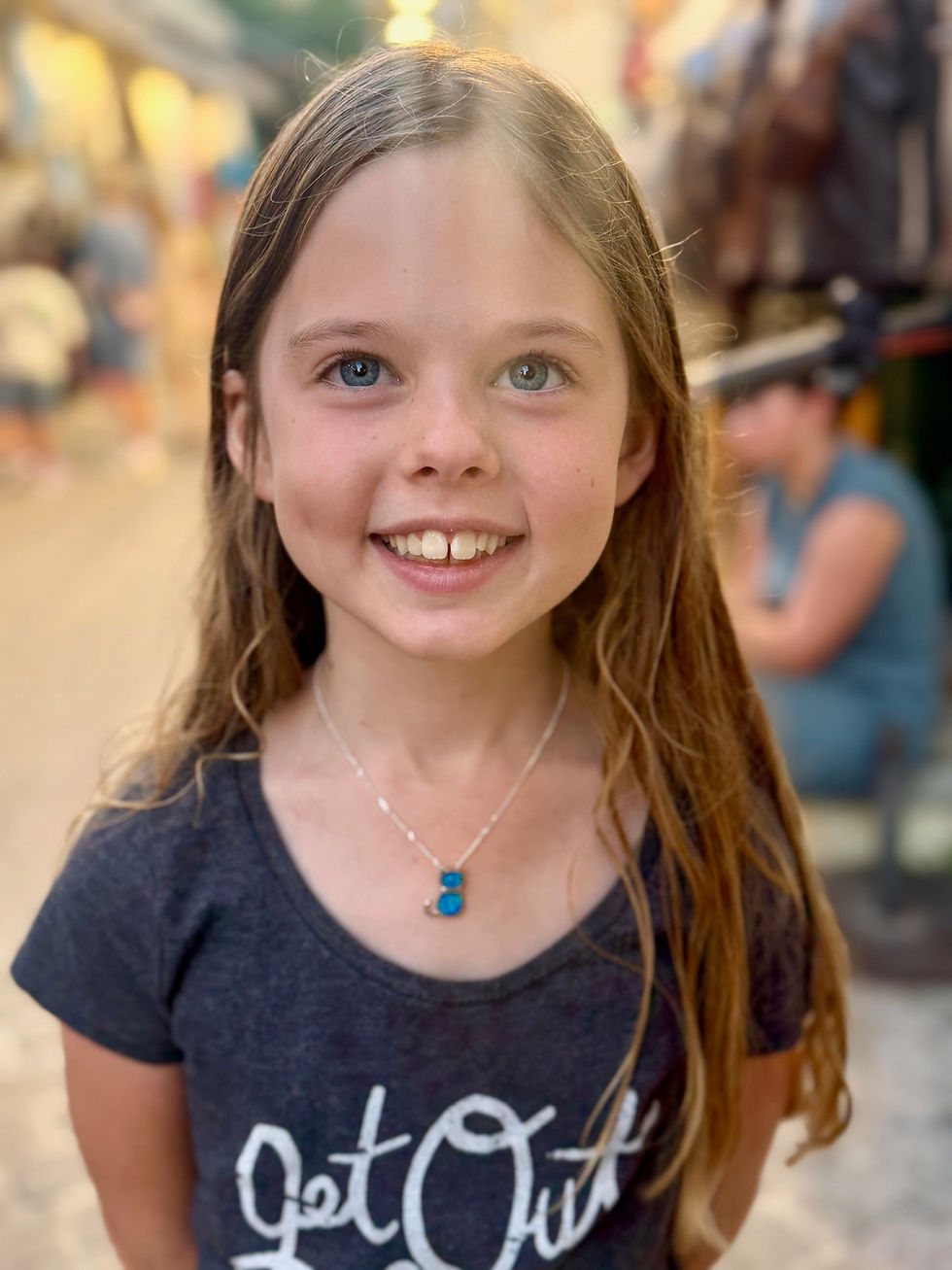
In the afternoon, we ambled outside the old town to a mysterious “9D” theatre. What is 9D, you ask? Well, if you ask me, it's a glorified vomit machine. Honestly, it was about to get 10D real fast if I didn’t get out of there soon.

It started off innocent enough with 3D images in the lobby while you wait to get inside the theatre.
Wearing our 3D glasses and seat belts???, we soared above Crete via drone footage—views of beaches, hidden coves, jagged cliffs, and mountaintop villages. “Damn,” I thought, “a week is nowhere near enough here.”

Then came the mythology. We witnessed the birth of Baby Zeus, born in a snowy mountain cave. We saw the Minotaur rage in the labyrinth and watched poor Icarus take his fatal flight too close to the sun on waxen wings. As we raced through dark corridors, soared into the sky, or plunged underwater, our chairs jolted, tilted, and spun like we were strapped to a helicopter with a drunk pilot.
When Icarus fell into the sea, we didn’t just watch—we fell with him, got splashed, and were immediately surrounded by bubbles as if we too had burst into the waves. When Zeus was born, cold wind slapped our faces and fake snow hit our glasses. And when we entered the dark labyrinth? Rats scurried beneath our feet and—surprise!—something whipped around our ankles. I screamed. Loudly. Liam just shook his head, laughing at my “bravery.”
But then… the final scene. The chair spun, dipped, and lunged. As if we hadn’t had enough, we needed a fun rollercoaster. Did we? I don’t do rollercoasters in real life, and I sure as hell don’t do them in spinning 3D chairs. I closed my eyes. Every peek triggered a new wave of stomach flips. I was legitimately worried the other viewers would get splashed with something other than hose water.
Liam, meanwhile, during the presentation, got blasted by a water cannon aimed—oddly precisely—at his right pectoral muscle, and he exited the theater soaked and laughing. At least the walk home in the heat won't feel so bad.

Reading this back, it sounds like I hated it. But honestly? It was a hoot. Maybe next time I’ll just bring some Dramamine and a towel.
I’ve got to give mad props to Giannis for his restaurant recommendations. That evening, we headed to Throumbi for dinner. Seated in a cozy courtyard in the heart of the old town, waiters buzzed past in earpieces, weaving between tightly packed tables, while a line six-deep waited out front.

If it’s even possible, this was our best meal yet. We went all in: Cured beef pie with sun-dried tomatoes, chicken phyllo rolls with spinach, mushroom, and graviera cheese, a rich meat stew in a savory sauce, mushroom ravioli, and bao buns.

Just as we pushed our plates away, sufficiently stuffed, the waiter brought over complimentary raki. It’s essentially Greek moonshine—clear, fiery, and served in a tiny bottle
shaped suspiciously like an antique poison jar. Coincidence? Doubtful. One sip in and we understood why. I’m still not convinced it’s meant for human consumption. Maybe it fuels fishing boats. Maybe it removes rust. Either way, it was not for us.

And then—the grand finale: A complimentary six scoops of vanilla ice cream nestled inside a graham cracker biscuit, drizzled with chocolate sauce.
The next morning, we left Chania early for a date with a gorge. One hour inland, snaking through the mountains toward Imbros, we traced a winding, inefficient path, the road like a wild river. We arrived at 9:30 am, greeted by a gusty cool wind that just about delivered us to the trailhead without any effort on our part.

We descended rocky steps and made our way into the gorge, my eyes glued to the uneven terrain, which left little opportunity to admire the sheer cliffs towering around us.

For 8 kilometers, we wandered through forested paths, dried-up riverbeds, and narrow canyons just wide enough for the kids to scramble up the walls like goats—some of which we actually passed along the way.

As we traced our way through the gorge, Kip recounted the story of the Battle of Crete in May of 1941 during World War II. After a devastating loss, allied troops used this gorge as an escape route to Hora Sfakion on the southern coast. Here, we followed the footsteps of 18,000 troops, primarily British, Australian, and New Zealanders.



About halfway through we came upon a donkey tied up next to a small shack. In this remote part of the gorge, someone set up shop and thought it was a good idea to sell beer and raki Nothing says “extreme hiking hydration” like local liquor in the middle of a canyon.

Eventually, the gorge spat us out beneath a grand stone arch and into a dusty parking lot where a group of taxis was ready to whisk tired hikers to Hora Sfakia.

Along the road, we couldn’t help but notice that every road sign had been turned into Swiss cheese—riddled with bullet holes. Apparently, the closer you get to this mountainous hunting playground, the more the signs double as target practice. Charming.

Hora Sfakia, a tiny town on the Libyan Sea, proudly claims its place in history as one of the few villages in Crete that successfully resisted Venetian rule from 1212 - 1669, allowing the Sfakians a modicum of independence. I guess, years later, they still feel the need to announce their sharp-shooting prowess.
From there, we boarded a short ferry across absurdly blue waters toward Loutro, a tiny fishing village that looks like an AI-generated postcard.



We lunched seaside, and gaped at the rowboats that, thanks to the clarity of the sea and the seemingly misplaced cast shadows, looked as if they were levitating. “Floating” took on a whole new meaning.



And speaking of floating… after lunch, we had an hour to do just that. In the calm, salty waters of the Libyan Sea, we drifted weightlessly.


Even 20 feet below your feet, the white sand bottom was crystal clear, as if the ocean had been freshly Windexed that morning.

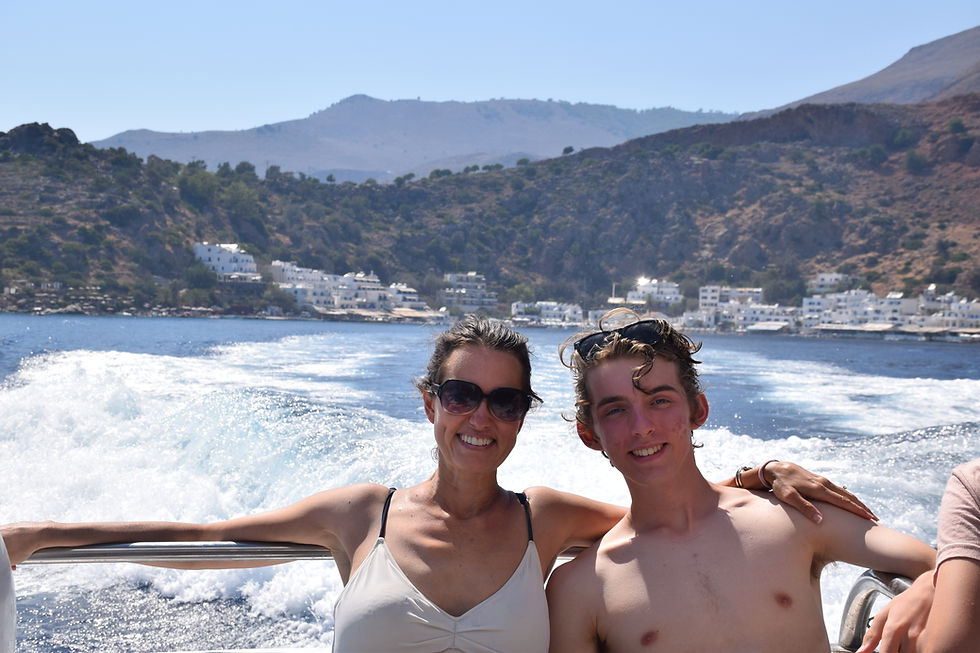
By the time we had traveled by car, ferry, foot, and taxi (driven by a Formula One racer with only bench seats in the back)—all in one day—we were collectively cooked. Kip drove back to Chania while the rest of us slipped into a silent, sun-saturated nap.

Our final day in Chania arrived with a familiar ache. The last day of any trip always hits me hard. You know how some people say, “Yeah, I can do ten days of travel, and then I’m ready to go home?” Yeah, not me. I’ve yet to find my upward limit. On this trip, Crete stole the show—it was the star of my highlight reel—and I wasn’t ready to let it go.
So while the rest of my family packed their bags, I slipped out for a quiet wander through Chania’s back alleyways, side streets, and tucked-away shops. I didn’t make it far.
My very first stop was a small boutique owned by a Ukrainian woman. We started talking about where we came from, where life had taken us, and how sometimes the curveballs come at you, and sometimes, if you're lucky, you get to throw them yourself. Before I left, she poured me a small glass of lemon-ginger raki, and we toasted to possibility. We hugged like old friends and wished each other luck.
I crossed the street—literally, just the street—and found myself in another shop owned by another Ukrainian woman, who offered me a glass of wine the moment I stepped inside. “What is this?” I thought. "Some strategy to get your customers tipsy enough to buy everything?”

Two glasses of wine and five shots of flavored raki later—not the paint thinner I'd had the night before, but the good stuff—we were fast friends. I finally stepped back out onto the street, frankly, a little buzzed at 11:30 am and not quite ready to head back, when I stumbled (not literally) across a table of older men singing their hearts out to a strumming guitar. Their voices were rich and full, soaring with that unmistakable operatic edge you hear in traditional Greek music.
One of them motioned me over and pulled out a chair. I sat. A shot of raki slid across the table toward me. "Oh, what the hell," I thought. They serenaded me with a Greek love song called Valentina, and my cheeks hurt from smiling. When they found out I was American, they broke into Country Roads by John Denver and Dust in the Wind by Kansas, and we all sang along.
For thirty golden minutes, we drank, laughed, and shared songs in a mix of languages and melodies. And I thought, this—this is the power of travel. Not just the sightseeing, the museums, or ruins. It’s the connection. The spontaneity. The moment you find yourself, unexpectedly, exactly where you want to be.

So, for now, hello and goodbye - Kalimera (Καλημέρα) and Antìo (αντίο), dear Greece.

Acknowledgments: This trip wouldn’t have happened without Kip’s meticulous research and next-level logistical acumen. The man read Greek and Crete guidebooks like they were thrillers—I’m honestly convinced he could lead tours tomorrow. And for the record, I fully support this career pivot… as long as I get to live here.

































































































































































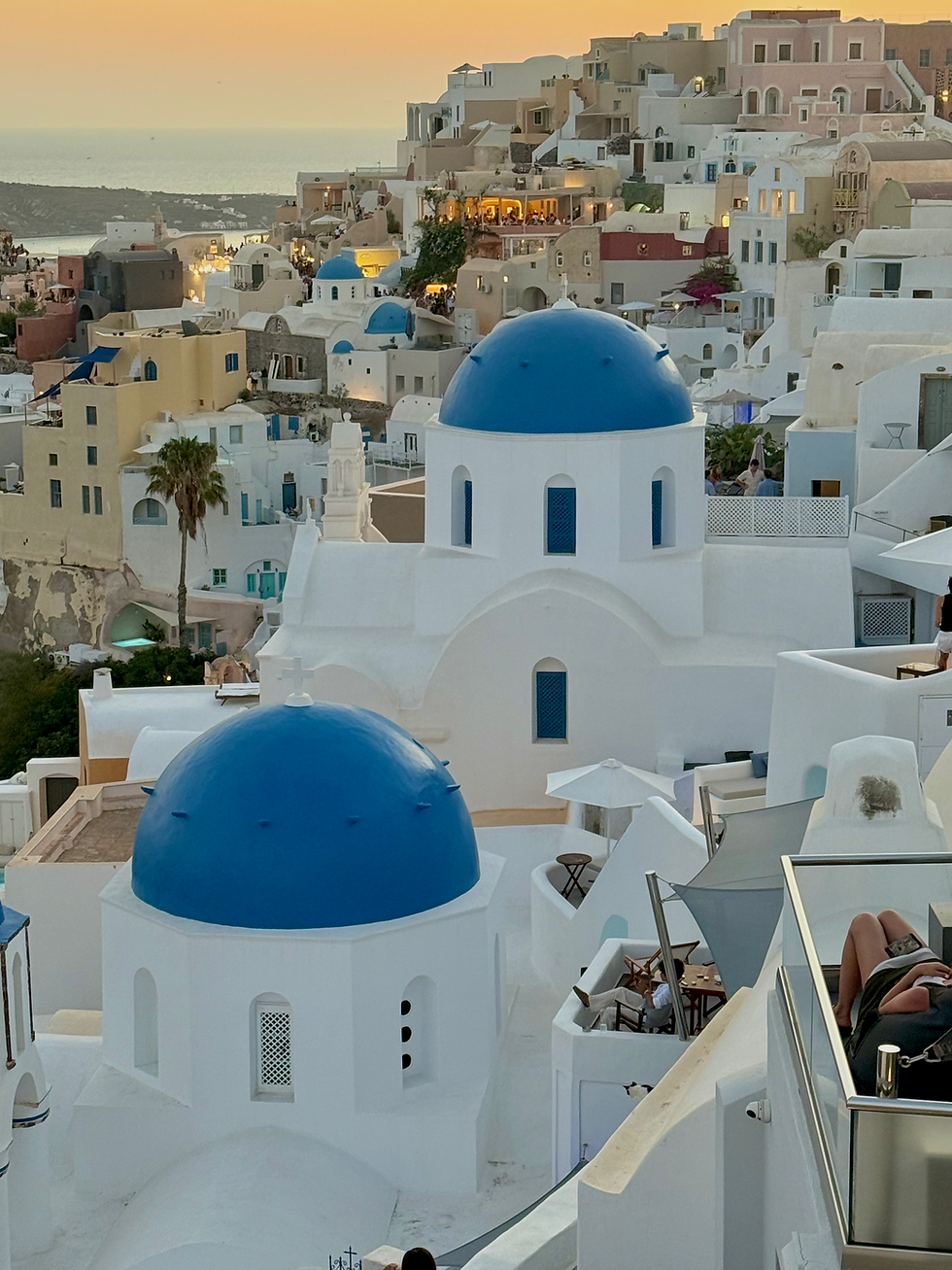


Amy , thank you for your fabulous blog. What a wonderful trip! Reading this and all the beautiful pictures has once again been the highlight of my summer!
Natalie Chiasson